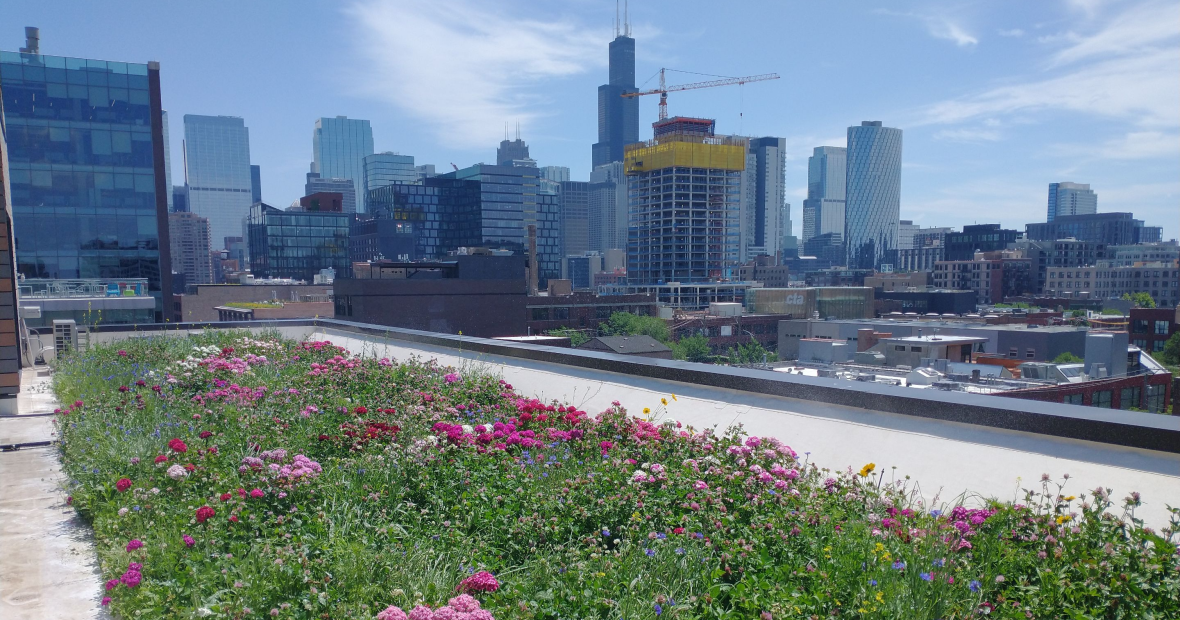Not Just Green: Wild
Michael Davenport ’92 Brings Biodiversity to Sustainable Architecture
Anika Jane Beamer '22
What’s the most biodiverse rooftop in Chicago? Michael Davenport ’92 could probably tell you.
Buildings — and the extraction of materials used to construct them — are one of the leading sources of global greenhouse emissions. Yet sustainable interventions in building architecture have proven to be impactful and cost-effective approaches to reducing emissions. Green roofs have grown in popularity as one such intervention. A layer of plant life atop a building provides insulation and reduces energy use, while also slowing the flow of stormwater runoff and minimizing erosion in the surrounding environment.
As Davenport explains, however, “Green roofs aren’t typically known for contributing to an environment’s biodiversity.” Construction projects occupy once wild land, but green roofs planted atop the new buildings usually consist of a thin layer planted with just one or two hardy species of sedum. When it comes to biodiversity, a roof is just not the same.
As the director of technical support at Omni Ecosystems in Chicago, Davenport is now leading the movement to create green roofs that prioritize biodiversity. Beyond the energy-conserving benefits of green roofs, Omni emphasizes ecosystem services — that is, they focus on the ways that a green roof can support insect and animal populations. “We’re putting biodiversity at the front of our work. All the other benefits of green roofs will follow if you can get that right,” Davenport says.
A Life Among Plants
Davenport has worked with plants for years, but he never imagined he’d be landscaping hundreds of feet above the ground atop office buildings that are part of the Chicago skyline. Then again, his journey to horticulture was far from linear.
At Grinnell, Davenport was an English major because, as he recalls, “I liked to read.” His first job after graduation was a telemarketing job. It was a terrible fit, Davenport says. “I realized really quickly that I was really having issues with a desk job and needed to be outside.”
After a series of jobs that were interesting but still not quite right, Davenport found work outdoors. He spent a few years working for the Central Park Conservancy in New York City, then moved to Asheville, N.C., to manage landscaping on the Biltmore Estate. All the while, his interest in plants — and his knowledge of them — grew.
In 2001, Davenport moved to Miami to work at Fairchild Tropical Botanical Garden. Surrounded by plants and botanists, the experience was “a wake-up call.” Finally, he felt he was where he was meant to be.
“Growing plants in a nursery environment, doing really rare and research-driven work, and having botanists to hang out with and talk to … it was kind of like my grad school,” says Davenport. He spent several years managing the botanical garden’s nursery, rising through the staff to the position of director of horticulture.
In 2010, Davenport and his partner moved back to the Midwest to raise a family. In Chicago, Davenport was hired as the curator of horticulture at Lincoln Park Zoo. His work at the zoo was unique, Davenport recalls. “I was learning all about Midwest prairie horticulture, but I was also having to work within the filter of, ‘will these plants be toxic to the animal collections?’ I had to be very careful, because a rhino will eat anything.”
While at Lincoln Park Zoo, Davenport witnessed the installation of green roofs on several new building projects. “But there was no real maintenance plan for those roofs,” he recalls. “That sparked something in me.”
Convinced there was a better approach to green roofs, Davenport’s research led him to Omni Ecosystems. “Omni had a totally different take on green roofs,” he says. Drawn to the company’s mission to prioritize biodiversity in green architecture, Davenport left the zoo to join the up-and-coming urban landscaping firm. That was six years ago.
Sky-High Wilderness
Omni builds roofs designed to evolve — just like any ecosystem, explains Davenport. The first plants to sprout from Omni’s “meadow mix” attract pollinators, facilitating the growth of native species that will eventually colonize the roof and provide vital food and shelter for local wildlife.
“I enjoy getting to witness the succession process over time,” Davenport says. “We now have documented over 750 plant taxa that we’ve grown successfully in our systems. That’s in contrast with the old style of green roofs that maybe has eight or 10 species of sedum.”
During his time at Omni, Davenport has led a movement to document the wildlife that the roofs attract. Beyond plants, he returns to roofs to track fungi, birds, and — his favorite — butterflies.
Davenport first got into planting for endangered butterflies when he was working in Miami, and he’s still keen on prioritizing insect life to attract other wildlife. “In a place like Chicago, birds come up from Lake Michigan and hit a massive stretch of concrete and urbanization. Having food-rich landing spots for these migratory birds is critical,” he explains.
Davenport can relate to these birds. “It’s a bit of a struggle in Chicago to find wild spaces,” he says. “I find that on these roofs.”


